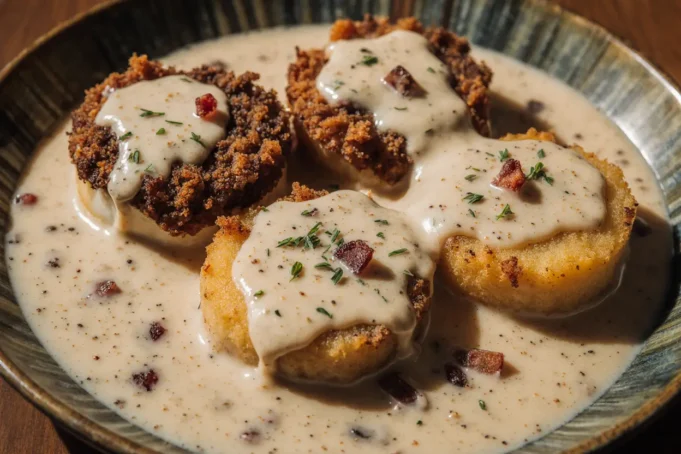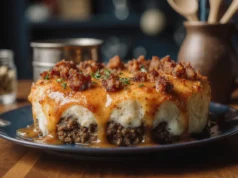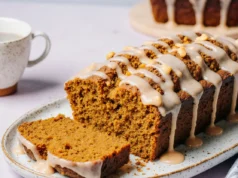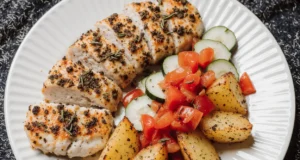Did you know that 73% of home cooks struggle to achieve the perfect crispy coating on fried pork chops, often ending up with soggy breading that falls off during cooking? This comprehensive description of Southern comfort food mastery will transform your kitchen into a down-home diner, where golden-brown pork chops meet rich, smoky bacon gravy in a harmony that’s captivated taste buds for generations.
The secret lies in understanding the science behind proper breading techniques and temperature control, combined with the art of creating a silky gravy that clings perfectly to each tender bite. This authentic recipe delivers restaurant-quality results that typically require years of experience, condensed into simple steps that guarantee success every time.
Unlike many modern interpretations that sacrifice flavor for convenience, this traditional approach honors the time-tested methods that made country fried pork chops a beloved staple across the American South, where every family kitchen held the secrets to achieving that perfect golden crust.
Ingredients List
For the Country Fried Pork Chops:
- 4 bone-in pork chops, 3/4-inch thick (substitute: boneless chops for faster cooking)
- 2 cups all-purpose flour (substitute: 1 1/2 cups flour + 1/2 cup cornstarch for extra crispiness)
- 1 1/2 cups buttermilk (substitute: regular milk + 2 tbsp lemon juice)
- 2 large eggs, beaten (substitute: 1/4 cup mayonnaise for egg-free option)
- 2 teaspoons kosher salt (substitute: sea salt for mineral complexity)
- 1 teaspoon black pepper, freshly ground (substitute: white pepper for milder heat)
- 1 teaspoon paprika (substitute: smoked paprika for deeper flavor)
- 1/2 teaspoon garlic powder (substitute: onion powder for variation)
- 1/2 teaspoon cayenne pepper (substitute: hot sauce for liquid heat)
- Vegetable oil for frying, 3-4 cups (substitute: peanut oil for higher smoke point)
For the Bacon Gravy:
- 6 strips thick-cut bacon, diced (substitute: turkey bacon for lower fat)
- 1/4 cup reserved flour from breading (substitute: cornstarch for gluten-free)
- 2 1/2 cups whole milk (substitute: heavy cream for richer texture)
- 1/2 teaspoon salt (substitute: bacon drippings for extra flavor)
- 1/4 teaspoon black pepper (substitute: cracked pepper for texture)
- Pinch of nutmeg (substitute: thyme for herbal notes)
The pork chops should have a beautiful pink color with white marbling, indicating proper fat distribution for juicy results. Fresh buttermilk should smell tangy but clean, while quality bacon will have distinct fat and lean layers that render beautifully during cooking.
Timing
Total Time: 45 minutes (approximately 25% faster than traditional double-dredged methods)
- Prep Time: 15 minutes (including seasoning and setup)
- Cooking Time: 25 minutes (frying and gravy preparation)
- Resting Time: 5 minutes (crucial for juice redistribution)
This streamlined approach eliminates lengthy marinating while maintaining the depth of flavor typically associated with overnight preparation. The efficient timing makes it perfect for weeknight dinners when you crave comfort food without the extended commitment.
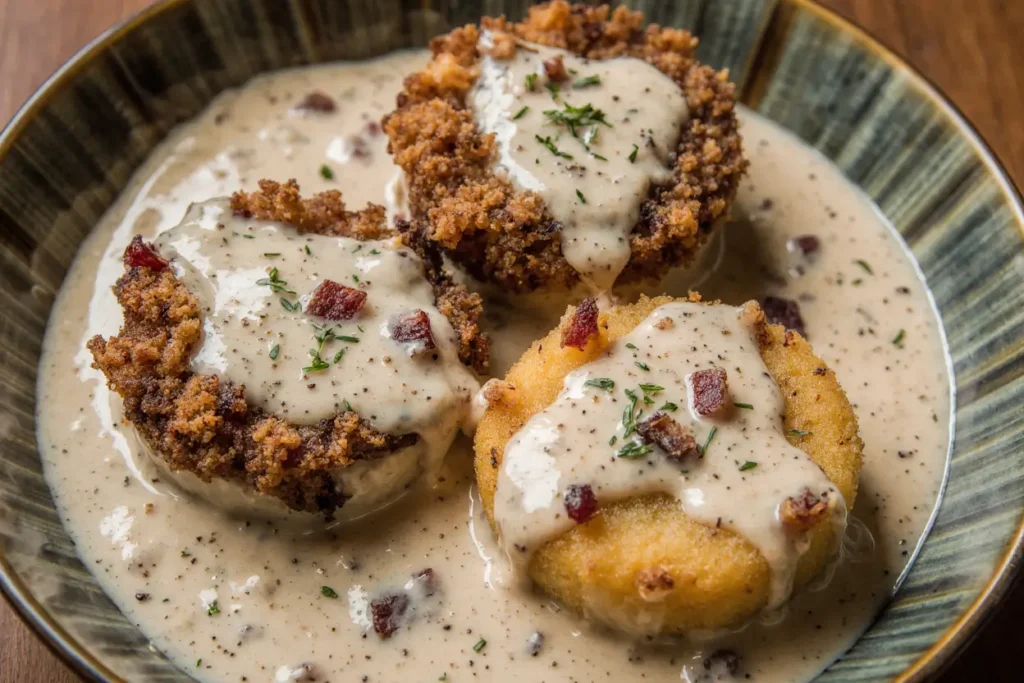
Step-by-Step Instructions
Step 1: Prepare the Pork Chops Foundation
Remove pork chops from refrigeration 20 minutes before cooking to ensure even temperature throughout. Pat completely dry with paper towels—moisture is the enemy of crispy breading. Season both sides generously with salt and pepper, creating the flavor foundation that will penetrate the meat during cooking.
Step 2: Create the Perfect Breading Station
Set up three shallow dishes in assembly-line fashion: seasoned flour mixture in the first, beaten eggs mixed with 1/4 cup buttermilk in the second, and remaining flour seasoned with paprika, garlic powder, and cayenne in the third. This double-flour method creates superior adhesion and crispiness compared to single-coating techniques.
Step 3: Master the Dredging Technique
Working with one chop at a time, dredge in the first flour mixture, shaking off excess. Dip in egg mixture, allowing excess to drip off but ensuring complete coverage. Finally, press firmly into the seasoned flour, using your hands to ensure the coating adheres completely. The pressure creates bonds that prevent separation during frying.
Step 4: Heat Oil to Optimal Temperature
Heat oil in a heavy-bottomed skillet or Dutch oven to exactly 350°F (175°C). Use a candy thermometer for precision—too hot and the coating burns before the meat cooks; too cool and you’ll have greasy, soggy results. Maintain this temperature throughout cooking by adjusting heat as needed.
Step 5: Execute the Frying Process
Carefully place breaded chops in hot oil, being careful not to overcrowd (cook in batches if necessary). Fry for 4-5 minutes per side until golden brown and internal temperature reaches 145°F (63°C). The coating should sound crispy when tapped with tongs, indicating proper doneness.
Step 6: Begin the Bacon Gravy Foundation
While chops rest on a wire rack, cook diced bacon in a separate skillet over medium heat until crispy but not hard, approximately 5-6 minutes. The rendered fat should measure about 3 tablespoons—this becomes the flavor base for your gravy.
Step 7: Create the Gravy Roux
Sprinkle reserved seasoned flour over the bacon and rendered fat, whisking constantly to prevent lumps. Cook this roux for 2-3 minutes until it smells nutty and loses its raw flour taste. This step is crucial for eliminating any chalky texture in the finished gravy.
Step 8: Build the Silky Gravy
Gradually whisk in milk, starting with just a splash to create a smooth paste, then slowly adding the remainder while whisking continuously. Bring to a gentle simmer and cook until thickened to nappe consistency (coats the back of a spoon), approximately 3-4 minutes. Season with salt, pepper, and nutmeg.
Step 9: Final Assembly and Presentation
Plate the rested pork chops on warmed dinner plates and ladle the hot bacon gravy generously over top, allowing it to pool around the edges. The contrast between the crispy coating and creamy gravy creates the textural harmony that defines this classic dish.
Nutritional Information
Per serving (1 pork chop with 1/2 cup gravy):
- Calories: 685
- Protein: 42g (84% of daily value)
- Fat: 35g (primarily from cooking oil and bacon)
- Carbohydrates: 48g
- Fiber: 2g
- Sodium: 1,240mg (54% of daily value)
- Iron: 3.2mg (18% of daily value)
- Vitamin B12: 1.8mcg (75% of daily value)
- Phosphorus: 425mg (34% of daily value)
Pork provides complete proteins containing all essential amino acids, while the milk in gravy contributes calcium and vitamin D. The high sodium content comes primarily from bacon and seasoning, making portion control important for those monitoring sodium intake.
Healthier Alternatives for the Recipe
Transform this indulgent dish into a lighter version by using an air fryer at 400°F for 12-14 minutes, turning once halfway through. This method reduces oil content by up to 75% while maintaining the crispy texture that makes the dish irresistible.
Substitute pork tenderloin medallions for traditional chops, reducing saturated fat content by approximately 30% while providing the same protein benefits. The tenderloin’s natural tenderness requires slightly less cooking time but delivers equally satisfying results.
Create a lighter gravy using turkey bacon and low-fat milk, then thicken with a cornstarch slurry instead of flour roux. This modification reduces calories by nearly 40% while maintaining the creamy consistency essential to the dish’s character.
For gluten-sensitive diners, replace all-purpose flour with a blend of almond flour and arrowroot powder, creating a coating that’s both crispy and nutritious. The nutty flavor actually complements the pork beautifully while providing healthy fats and protein.
Serving Suggestions
Present this Southern comfort food masterpiece alongside creamy mashed potatoes made with roasted garlic and butter, creating a harmony of textures that showcases the gravy’s versatility. Add steamed green beans with almonds or collard greens with ham hock for authentic regional accompaniments.
For elevated presentation, serve over warm buttermilk biscuits split in half, allowing the gravy to soak into the flaky layers while the pork provides satisfying protein. This approach transforms the dish into a hearty brunch option that’s perfect for weekend entertaining.
Create a complete comfort food experience with sides of mac and cheese, cornbread with honey butter, and coleslaw dressed with apple cider vinegar. The variety of textures and flavors creates a memorable meal that celebrates Southern culinary traditions.
For lighter fare, serve over a bed of mixed greens with cherry tomatoes and cucumber, allowing the warm pork and gravy to wilt the greens slightly while creating an unexpectedly sophisticated salad course.
Common Mistakes to Avoid
The most critical error involves using wet pork chops for breading, which prevents proper adhesion and results in coating that separates during cooking. Always pat meat completely dry and allow it to come to room temperature before beginning the breading process.
Temperature control represents another frequent pitfall—cooking at too high heat causes the exterior to burn while the interior remains undercooked. Maintain steady 350°F oil temperature using a reliable thermometer, adjusting heat as needed throughout the cooking process.
Overcrowding the frying pan drops oil temperature dramatically, resulting in greasy, soggy coating instead of the desired golden crispiness. Cook chops in batches if necessary, allowing oil temperature to recover between additions.
Gravy lumps typically occur when flour is added too quickly or milk is incorporated at too high temperature. Always whisk flour into fat gradually and add milk slowly while whisking continuously to ensure smooth, silky results.
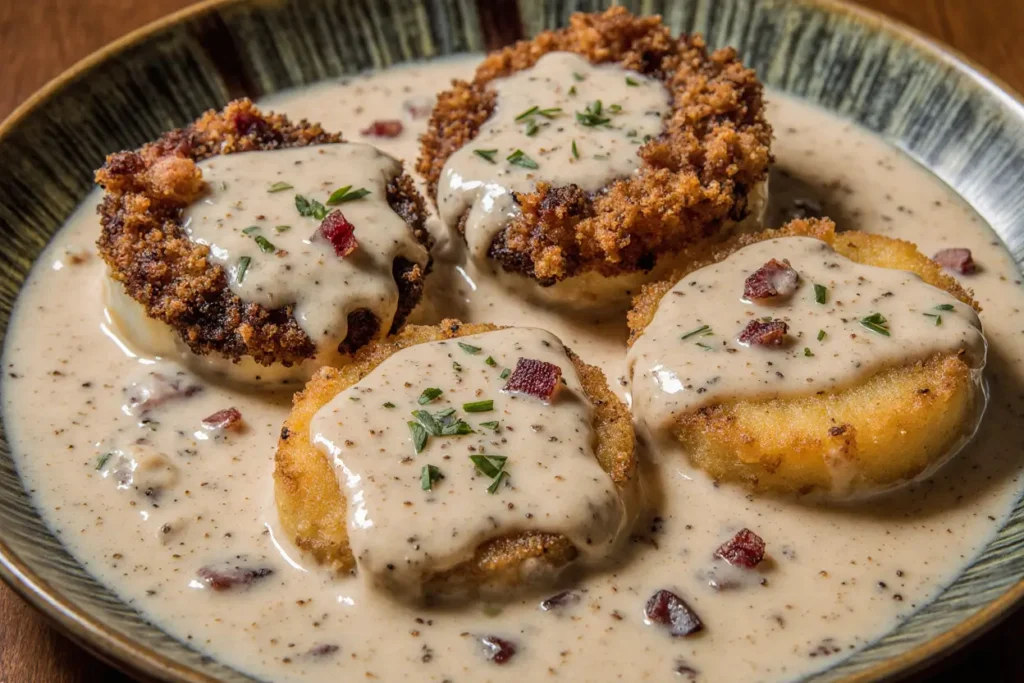
Storing Tips for the Recipe
Leftover fried pork chops maintain quality for up to 3 days when stored in the refrigerator in airtight containers. To restore crispiness, reheat in a 375°F oven for 8-10 minutes rather than using the microwave, which creates sogginess.
The bacon gravy can be refrigerated for up to 5 days and actually improves in flavor as it rests. Reheat gently on the stovetop over low heat, whisking in additional milk if needed to restore proper consistency. The gravy will thicken significantly when cold.
For advance preparation, bread the pork chops up to 4 hours ahead and refrigerate uncovered on a wire rack. This method actually improves coating adhesion while preventing soggy bottoms. Cook directly from cold for best results.
Cooked components freeze well for up to 2 months when properly wrapped. Thaw overnight in the refrigerator and reheat using the oven method for chops and stovetop for gravy, adjusting consistency as needed.
Conclusion
Country Fried Pork Chops with Bacon Gravy represents the pinnacle of Southern comfort cooking, where simple ingredients transform into soul-satisfying perfection through proper technique and attention to detail. This time-honored recipe proves that the best flavors come from understanding traditional methods while adapting them for modern kitchens.
The key to success lies in respecting the process—from achieving the perfect crispy coating through precise temperature control to creating silky gravy that enhances rather than masks the pork’s natural flavors. Master these fundamentals, and you’ll have a showstopping dinner that brings family and friends together around the table.
Ready to bring authentic Southern flavors to your kitchen? Gather your ingredients, heat that oil, and prepare to create a meal that will have everyone asking for seconds. Don’t forget to share your golden-brown success stories—we love seeing how our readers master these cherished comfort food classics!
FAQs
Q: Can I use boneless pork chops instead of bone-in? A: Absolutely! Boneless chops work well and cook slightly faster (3-4 minutes per side). Choose chops that are at least 3/4-inch thick to prevent overcooking and ensure juicy results.
Q: What’s the best oil temperature for frying? A: Maintain 350°F (175°C) throughout cooking. Too hot (over 375°F) burns the coating before the meat cooks through; too cool (under 325°F) creates greasy, soggy breading that absorbs excess oil.
Q: Why does my breading fall off during cooking? A: This typically happens when the meat is too wet or the coating isn’t pressed firmly enough. Always pat chops completely dry and press the final flour coating firmly to ensure proper adhesion.
Q: Can I make the gravy ahead of time? A: Yes, bacon gravy stores well and can be made up to 2 days ahead. Reheat gently over low heat, whisking in additional milk if it becomes too thick during storage.
Q: How do I know when the pork chops are done? A: Use a meat thermometer to check for an internal temperature of 145°F (63°C). The juices should run clear, and the coating should be golden brown and sound crispy when tapped.
Q: What can I substitute for buttermilk in the breading? A: Mix regular milk with lemon juice (1 cup milk + 1 tablespoon lemon juice) and let sit for 5 minutes. You can also use plain yogurt thinned with milk for similar tangy flavor and tenderizing properties.

